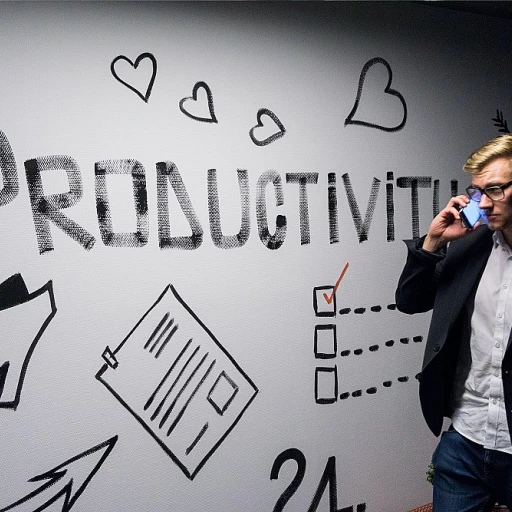
Understanding the Importance of Continuous Learning
The Critical Role of Lifelong Learning
In today's fast-paced world, the term "continuous learning" is not just a buzzword; it's a necessity for personal and professional growth. The importance of continuous learning cannot be overstated, especially when we consider the rapidly evolving job market and the constant technological advancements reshaping industries. To remain relevant and competitive, individuals and organizations alike must embrace lifelong education.
For professionals, mastering the art of learning blue becomes a valuable strategy. Continuous development enhances soft skills, boosts employee engagement, and fosters effective leadership. It helps fill the gaps in knowledge and skills, allowing team members to perform better in their roles and contribute to the wider goals of the organization.
Moreover, in the context of work, continuous learning means more than just attending training programs. It involves participating in a range of activities—from reading blogs and articles on current best practices, to engaging in virtual and augmented reality experiences that offer simulation training. This mix of traditional and experiential learning fosters greater flexibility and creativity among employees.
It's also essential in addressing the growing need for diversity training and DEI (Diversity, Equity, and Inclusion) initiatives. By understanding different perspectives and enhancing their soft skills, employees can better navigate the complexities of today’s corporate environment. Furthermore, continuous learning promotes mental health by empowering individuals to adapt and manage stress better through improved exercise science and mental resilience.
The benefits of a lifelong learning mindset extend beyond individual growth. Organizations that prioritize continuous learning initiatives, such as cls fill and corporate training programs, tend to see more engaged employees and improved outcomes. Incorporating best practices in employee training or even improvising simulation training only enhances the growth trajectory, both for employees and the enterprise as a whole.
Overcoming Barriers to Lifelong Education
Identifying Common Challenges
Continuous learning is an admirable pursuit, but it's not without its fair share of obstacles. As individuals strive to enhance their skills, they often face barriers that can impede their educational journey. These hurdles can range from personal to institutional, but with the right mindset and resources, they can be overcome.Personal Obstacles
Personal challenges such as time constraints, lack of motivation, and mental health issues can significantly deter one's journey in learning. Balancing work, family, and learning commitments demands a high level of discipline and effective time management skills. It is vital to acknowledge and address these challenges proactively. Developing a routine that accommodates all responsibilities and prioritizes well-being can create a conducive environment for continuous education.Institutional and Organizational Barriers
From an organizational perspective, companies sometimes neglect the importance of employee training programs, which can hinder professional development. Limited opportunities for experiential learning and inadequate access to diverse training resources can stymie growth. Moreover, there's often a lack of support for soft skills and diversity training, which are increasingly relevant in today’s work environment. Organizations that invest in corporate training, encompassing leadership and team development, see significant returns in employee engagement and productivity. Trainers can incorporate best practices by using simulation training and experiential learning techniques, ensuring employees not only learn but also apply knowledge effectively.Technological Challenges and Solutions
While technology aids learning remarkably, there remains a challenge in keeping up with the latest advancements. Virtual platforms, augmented reality, and social media offer vast potential to boost training programs but can sometimes overwhelm learners who are not tech-savvy. For effective utilization, organizations should provide training on using these technologies, ensuring the tools become assets rather than detriments. For a more in-depth exploration of overcoming barriers and identifying key areas of knowledge in lifelong learning, you can read our detailed analysis on continuous learning. By addressing these barriers, both individuals and organizations can unlock the full potential of continuous learning, paving the way for personal and professional growth.Effective Strategies for Continuous Learning
Adopting a New Mindset for Learning
To be effective in continuous learning, shifting one's mindset is crucial. To truly embrace learning, individuals need to cultivate a growth mentality, viewing challenges as opportunities for growth rather than obstacles. This shift requires commitment to personal and professional development through adaptive strategies.Engaging with Diverse Learning Sources
A variety of resources is key to a well-rounded learning experience:- Reading and Online Content: Dive into books, blogs, and training articles to continuously enhance knowledge.
- Employee Training Programs: Businesses often offer comprehensive programs—like diversity training and leadership development—to help fill skill gaps among employees.
- Experiential Learning: Hands-on experiences, such as simulation training, enable employees to learn by doing, which is among the best practices for skill retention.
- Augmented Reality and Virtual Exercises: These technological advancements provide powerful tools in corporate training and employee engagement strategies, offering immersive learning experiences.
Incorporating Best Practices
Integrating structured learning models can significantly boost one’s learning curve. This includes combining formal training programs with informal learning opportunities. Making use of both traditional methods like classroom study and modern tactics such as virtual classrooms and social media forums can lead to effective outcomes.Leveraging Professional Development Opportunities
Taking advantage of professional training programs is crucial for maintaining an edge in the workplace. Programs focusing on soft skills, exercise science, and DEI training equip employees with the necessary tools to excel. In addition, engaging with essential interview questions can further enhance one's preparation and performance in professional settings. Recognizing the significance of work-life balance and mental health is fundamental for sustainable learning and development. As continuous learning grows in importance, integrating these strategies becomes paramount in supporting employees and organizations alike.Leveraging Technology in Learning
The Role of Technology in Modern Learning
Leveraging technology in learning has revolutionized how we approach education and employee training. From virtual classrooms to advanced simulation training, the integration of technology allows for more dynamic and personalized learning experiences. It's not just about reading from textbooks anymore; technology offers a vast array of tools to enhance both traditional and modern educational methods. For organizations, investing in technology-driven training programs can lead to more effective training sessions. Employees can engage in experiential learning through augmented reality, allowing them to develop soft skills and embrace diversity training in practical settings. Moreover, technology facilitates training growing continuously as trainers can update and deliver content in real-time, ensuring that employees are always equipped with contemporary knowledge and competencies. Corporate training often involves a blend of virtual and in-person learning, which eases the challenge of balancing work and ongoing education. With platforms dedicated to professional development, employees can swiftly access resources, such as best practices in leadership and team management, helping maintain both productivity and mental health. Engagement is another crucial aspect where technology plays a pivotal role. Training programs that integrate social media tools can boost employee engagement by creating a community where learners can share experiences and insights. Additionally, technology supports CLS (continuous learning systems), allowing organizations to fill gaps in skills development by offering targeted employee engagement strategies. The efficiency of technology in learning also extends to measurement. Tools are available to assess employee participation, progress, and performance, enabling organizations to evaluate the success of their training employees programs. Through such comprehensive methods, companies not only enhance their workforce's capabilities but also encourage a culture of lifelong learning that meets the demands of the modern workplace.Balancing Learning with Daily Life
Integrating Learning into Daily Routines
Embracing continuous learning requires a delicate balance between acquiring knowledge and managing everyday responsibilities. One of the key steps in achieving this balance is to integrate learning seamlessly into daily routines without overwhelming oneself.- Time Management and Prioritization: Structuring your schedule to include designated learning periods can help in maintaining a consistent learning pace. It ensures that knowledge acquisition does not interfere with essential duties at work or in personal life.
- Flexible Learning Options: Online courses and virtual training programs offer flexibility, allowing learners to access materials at their convenience. This reduces pressure and creates a more conducive environment for absorbing information effectively.
- Experiential Learning: Incorporate experiential learning methods such as simulation training, which can be both engaging and comprehension-enhancing. These methods, including augmented reality, provide practical, hands-on experiences crucial for skills development.
- Leveraging "Downtime": Utilize moments of waiting or commuting to engage in productive activities like listening to audiobooks or participating in webinars about soft skills or leadership development.
- Integrate Learning with Work: Connect learning objectives with work tasks. For instance, apply new techniques or strategies acquired during corporate training directly in your projects to reinforce learning through real-world application.
- Employee Engagement and Well-being: Employers can foster a culture of learning by integrating ongoing employee training into the work environment. This not only builds on professional development but also positively affects employee engagement and mental health.
Measuring Success in Continuous Learning
Evaluating the Impact of Your Learning Journey
When it comes to gauging success in continuous learning, it's essential to have a nuanced approach. Developing skills and knowledge is an ongoing journey, and measuring progress can be complex. Here's how to assess whether your efforts are effective and where you might need to adjust:
- Set Clear Goals: Without clear goals, it can be challenging to recognize achievements. Define what success looks like in your learning and development context. Whether it's gaining proficiency in a new language or mastering leadership skills, clearly defined objectives help measure progress.
- Track Progress: Implementing tools and metrics is vital for monitoring your learning path. For professionals in employee training or corporate training, using data from experiential learning projects or simulation training can provide insights into skills acquired.
- Obtain Feedback: Whether you're involved in training programs or self-directed study, feedback is crucial. Engaging with trainers or participating in team discussions can offer different perspectives and highlight areas for improvement.
- Engage in Reflective Practices: Reflection helps consolidate learning. Taking the time to read or engage in reflective writing in a blog can solidify what you've learned and identify gaps.
- Assess Soft Skills: Development of soft skills, such as communication and leadership, is often more challenging to measure than technical skills. Consider using peer reviews or self-assessment tools to gauge growth in these areas.
- Consider Health and Well-being: Continuous learning should not come at the expense of your mental or physical health. Ensure that your learning efforts positively impact your overall well-being. Balancing learning with daily life, as discussed earlier, aids in maintaining mental health and engagement.
Remember, success in continuous learning isn't just about acquiring knowledge but about holistic development and adaptability. The ultimate metric is how effectively you can apply what you've learned in real-world settings, contributing positively to your professional life and personal growth.












